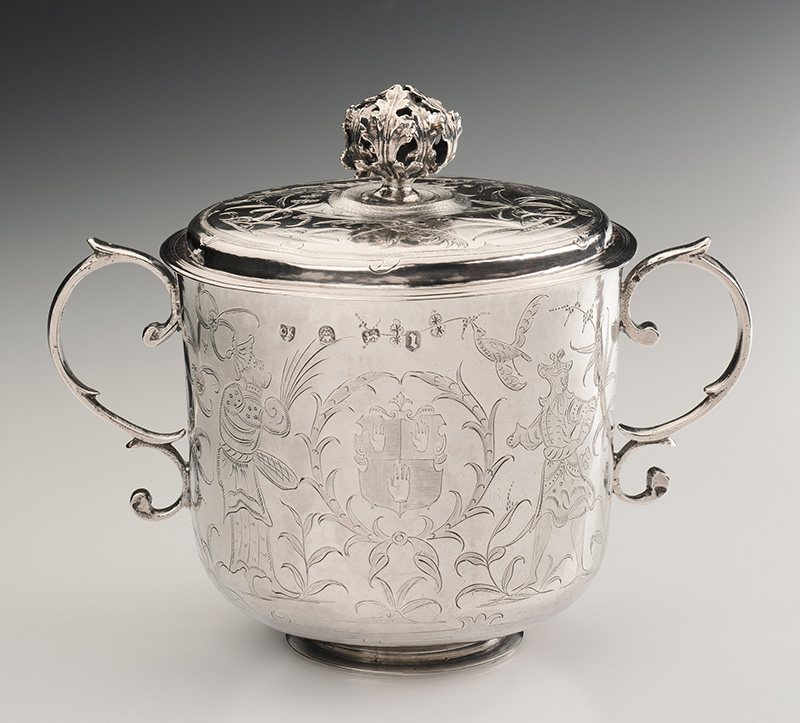Chinese Metalwork and English Restoration Silver in the “Chinese Taste”
Click on images to enlarge them and view captions.
by Susan Eberhard
In the history of English Restoration silver, the “Chinese taste” is understood as a type of Chinoiserie—that is, an idealized imagery of China created by Europeans—in vogue from about 1675 to 1720. In his landmark study, Chinoiserie: The Vision of Cathay (1961), Hugh Honour noted: “Some of the earliest indications of the Restoration taste for chinoiserie are to be found in the decoration of silver… Chinoiserie japan [lacquer], pottery, and textiles produced in the first half of the century were all inspired by, if not directly imitative of, objects of similar materials imported from the Orient. But so far as is known, no silver or gold, apart from filigree, was brought to Europe from the East at this period. The notion of applying eastern-style decorations to silver tankards and bowls was therefore as novel as it was strange.”1
With this intriguing passage, Honour raised the stakes for my summer research project, which was generously supported through a grant endowed by the Decorative Arts Society of Orange County and awarded by the Decorative Arts Trust. Namely, the earliest glimmers of the Chinese taste in England emerged within the goldsmiths’ trade. What did metals offer in terms of conveying notions of Asia? Where—or to whom—did English goldsmiths and goldsmith-chasers turn when sourcing their global imaginaries?
The decorations referenced by Honour reflect two approaches to surface ornament, which silver scholars have periodized together as the Chinese taste. One is a type of relief often created through the additive technique of appliqué with delicate raised surfaces contrasted against a punched, matted ground (figure 1). The other type was achieved on a shiny, reflective surface through the application of struck marks, such as dashes and dots, that accumulated into lines and textures (figure 2).
Testifying to a taste for the exotic, the designs include robed figures, birds, flowers, plants, and architectural ruins, and appear on objects such as monteiths, two-handled cups, and plates. Often called Chinoiserie flat-chasing, David Mitchell has identified the 17th-century term as “japan work.”2 Since the 1975 publication of Chinese Export Silver and related articles, scholars have become aware of examples of Chinese silver brought to England in the 17th and 18th centuries.3 Thus silver in the Chinese taste has operated as an umbrella term for both Chinese and English objects, but what about the design source(s) for the flat-chased ornament? Should we disaggregate the Chinese taste into raised and flat ornament, as well as into Chinese and English objects?
Silver scholars have not identified any original patterns for the flat-chased designs but surmise that they were a blend of imagery from European illustrated books on Asia and decorations on Asian objects such as lacquer and porcelain.4 They have considered questions of authorship: whether the chasing was done by a single goldsmith, a workshop, or by multiple workshops. Yet what intrigued me is that the technique used to create the chasing was rarely used for other English surface ornament. Further, it seemed to reference a three-dimensional source—perhaps even metalwork.
I surmised that English goldsmith-chasers were looking at imported Chinese metalwares, perhaps imported Chinese pewter vessels with decorated surfaces. I visited the Field Museum in Chicago and examined approximately fifty examples of Qing period (1644–1911) Chinese metalwares. Most of the objects were pewter tea utensils, containers, and pouring vessels with inlaid copper alloy ornament. My examination of the Chinese pewter revealed similar surface chasing techniques, such as the figures on a lidded jar (figures 3 and 4). Further, there is fascinating evidence of selective design transfers. The likelihood of metal-to-metal design transfer reveals that decorative arts, and metalwork specifically, are often overlooked design sources. Moreover, Restoration silver in the Chinese taste is a case of what Anne Gerritsen and Girgio Riello have described as “global spaces of creation,” or direct creative transfers between makers.5 By sorting the two types of ornament neatly into their respective cultural systems, we risk diluting or overlooking the nuanced complexities of their historical imbrications, as well as the problems they each pose to a global history of ornament.
- Hugh Honour, Chinoiserie: The Vision of Cathay (London: J. Murray, 1961), 69.
- Silversmiths in Elizabethan and Stuart London: Their Lives and Marks (London: The Boydell Press for the Goldsmiths’ Company, 2017), 75–6.
- H.A. Crosby Forbes et al., Chinese Export Silver, 1775 to 1875 (Milton, MA: Museum of the American China Trade, 1975).
- For a summary, see Beth Carver Wees, English, Irish and Scottish Silver at the Sterling and Francine Clark Art Institute (New York: Hudson Hills Press, 1997), 72-3.
- “Spaces of Global Interactions: The Material Landscapes of Global History,” Writing Material Culture History, eds. Gerritsen and Riello, 2nd ed. (London, UK; New York, NY: Bloomsbury Publishing, 2021), 113.
Susan Eberhard is a PhD candidate in the History of Art department at the University of California, Berkeley.
A print version of this article was published in The Magazine of the Decorative Arts Trust, one of our most popular member benefits. Join today!




